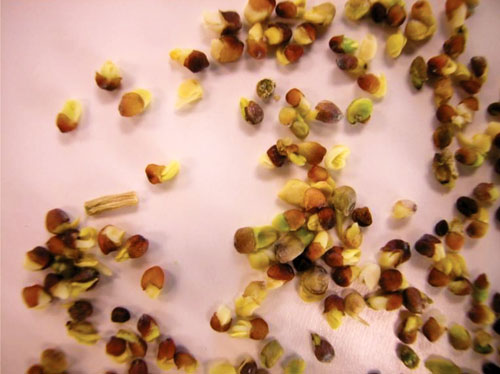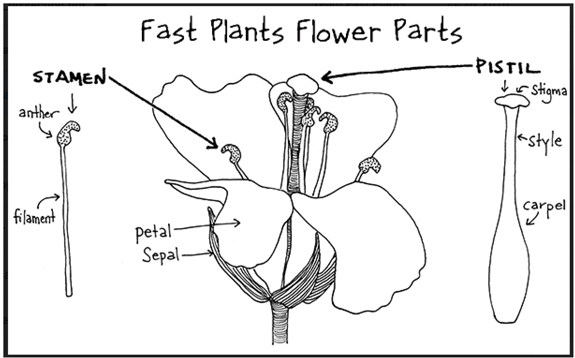Producing Fast Plants seed for investigations that need offspring generations
Seed harvest is an essential step in any Fast Plants experimental design that involves gathering evidence from offspring plants that students produce themselves. For example, you may have students conduct an inheritance investigation in which they inter-mate Fast Plants from an F1 generation to produce and observe the F2 offspring. Similarly, a selection investigation typically engages students in selecting for a trait they want to try increase in frequency in the next generation. So, the parent population is reduced to just those plants exhibiting the trait to be increased, students cross-pollinate and produce offspring generation seed. Whatever the investigation may be, when producing viable seed is required, seed harvest in an important consideration for the success of the investigation.
In this post, we share seed harvest tips from our Fast Plants seed experts. Read on to learn practical guidelines and background information organized around four questions:
- How do I know when it’s safe for seed harvest to begin?
- Is it possible to tell by looking at Fast Plants seeds when they are mature?
- After seed harvest, when is it safe to plant the seeds?
- How are pollination, fertilization, and seed development related?

How do I know when it’s safe for seed harvest to begin?
Timing seed harvest is an important biological consideration. On one hand, if you harvest the seed pods too early, the embryos will not be fully developed. In this case, the seeds will be tiny, shriveled, and unlikely to germinate to produce the next generation. On the other hand, if you let the plants continue to grow and harvest too late, the developing embryos will fully mature, and the seeds will begin pre-germ (precocious germination) inside the seed pods. The key is finding a happy medium, with seed harvest timed for when embryos are developed and mature, but before pre-germ begins.


On average, Fast Plants seed embryos are fully developed approximately 20 days after the last day of pollination. At this point, we recommend removing the plants from water and letting the plants dry until the seed pods are brown and crispy. During this drying time, we recommend keeping the plants under lights (the lights and warmth help seed pods mature). Then, when seed pods are completely dry, seeds can be harvested by rolling the pods between your fingers, collecting the seeds that fall out.
Is it possible to tell by looking at Fast Plants seeds when they are mature?
For the experienced Fast Plants’ farmer, seed harvest includes testing seed maturity by inspection. In other words, you can gain insights into the maturity of your seeds by opening a few pods and examining the seeds within. However, use caution, as opening pods before maturity usually results in loss of those pods opened. Therefore, examining pods in detail is best performed when you have a large plant population, successful pollination, and can afford to lose a few pods.
Start by selecting two or three seed pods to examine, making sure to note where on the plant the pods were growing. This is important because seed pods that are low on the plant’s main stem are from the plant’s first flowers, typically the first to be pollinated, and thus are usually the fastest to mature. Seed pods that are high on the plant’s main stem or on side branches are usually from later pollination and may mature slightly slower.

Sampling of seeds ready to be dried.
When examining seeds, consider the following:

- If a seed is pearly, milky, or translucent, it is too young to harvest. These seeds will be soft and have a high water content with an immature embryo. If harvested at this point, seeds will dry, shrivel excessively and may not germinate.

- If a seed is dark green with defined structures within, it is nearing maturity. These seeds will be firm, have a low water content with a mature embryo, and the plant is likely ready to be taken off water and begin drying. Ending the water supply and allowing dry-down at this point will continue to mature the seed to its final color, yielding healthy viable seeds.

- If a seed is large and firm, and starting to fade to yellow or brown, the seed is mature and plants should be taken off water immediately. Delaying harvest at this point can result in undesirable pre-germination. Keeping plants under light while they dry will minimize pre-germ.

- If pre-germ is observed in only a few seeds, you can expedite dry-down by cutting plants at the base of the stem. In general, keeping plants in dry conditions after you stop watering (~20 days after the last pollination) helps with successful seed harvest. Similarly, keeping plants under light while they dry can minimize pre-germ.
After seed harvest, when is it safe to plant?
Over the past 40 years of selection, seed dormancy has been bred out of Fast Plants varieties. Therefore, once the seed pods are completely dry and successfully harvested, the seeds within are ready to replant.
One exception to this lack of seed dormancy is the Rosette-Dwarf seed stock. Lack of Gibberellic acid (a plant hormone) in Rosette-Dwarf plants, seems to slow overall plant and seed maturation. As a result, Rosette-Dwarf seeds typically need to be set aside for a few more weeks before replanting.

seed pods developing and filling with
seeds after successful pollination.
How are pollination, fertilization, and seed development related?
Pollination has occurred when pollen is transferred from a flower’s anthers to another flower’s stigma. After a successful pollination, each compatible pollen grain adhering to the stigma sends a tube through the style. This tube carries two male gametes (sperm cells) to the ovule, where the egg and the other cell nuclei are contained in the embryo sac. One sperm unites with the egg cell producing a zygote which becomes the embryo. The second sperm unites with two polar nuclei in the ovule, fusing to form the triploid endosperm, the food source for the developing embryo.

This process is known as double fertilization. Endosperm resulting from the fusion of one of the two male gametes with the two ovular polar nuclei grows mainly as noncellular tissue, filling the enlarging ovules. The embryo’s development is then nourished by the endosperm. Within 2 to 3 days after fertilization, the pistil’s carpel elongates and swells to become a seed pod, containing the fertilized ovules. The sepals and petals wither and drop off, having completed their functions.
After pollination, between days 17 – 35 in the Fast Plants’ life cycle, embryos are developing into seeds. The embryos go through a series of developmental stages, known as embryogenesis, and enlarge, filling the space occupied by the endosperm. Through the development of seeds, the plant “packages” its next generation (embryos) to survive until favorable growth conditions promote germination. As each seed nears maturity, the wall of the ovule develops into a protective seed coat.
If you still find yourself wondering about when to harvest or plant seeds for the next generation, you can snap some photos of your plants and seed pods and email them to our Fast Plants team (info@fastplants.org) at with the following information:
- Fast Plants variety
- Type of growing and lighting system used
- Number of days since you stopped pollinating
- Any other information about whether they’re still receiving water via water reservoir, etc.

